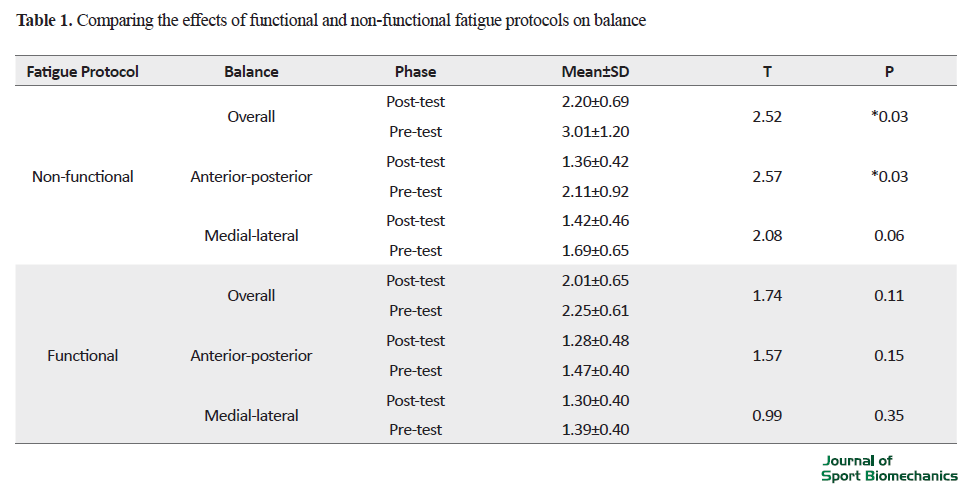BibTeX | RIS | EndNote | Medlars | ProCite | Reference Manager | RefWorks
Send citation to:
URL: http://biomechanics.iauh.ac.ir/article-1-193-en.html
2- Department of Sports Biomechanics, Faculty of Physical Education and Sports Sciences, Bahonar University, Kerman, Iran.
1. Introduction
Basketball is one of the most popular sports around the world. Twisting, cutting, jumping and landing are among the main movements of this exciting sport, which increases the risk of injury. 65% of injuries in this sport occur in the lower extremities, the most common of which is ankle sprain. One of the causes of lower extremity injuries is a defect in the nervous/muscular system and control of posture and balance. Various factors affect the nervous/muscular system and balance; fatigue is one of these factors.
Muscle fatigue reduces the capacity of muscle to produce tension and power output after repeated muscle contraction, which results in decreased proprioception system function and impaired motor function. There are various methods and protocols for fatigue induction such as isokinetic contractions, repetitive movements, isometric contractions, and functional activities. Due to the lack of research to control the dynamic posture and fatigue caused by exercise, conducting studies using functional fatigue protocol similar to exercise as well as non-functional fatigue protocol and comparing them improves the postural control of players. In this regard, this study aimed to compare the effects of functional and non-functional fatigue protocols on dynamic balance of Basketball players (Table 1).

2. Methods
Participants were 10 physical education students of Shahid Bahonar University of Kerman in Iran with a mean age of 21.4±1.5 years, mean height of 177.5±7.1 cm, and mean weight of 67.4±8.5 kg who had at least one year of college basketball experience who were selected using a convenience sampling method. All participants signed a written consent form to participate in this research after being informed of the test conditions. The testing process was performed in three sessions (one-week rest interval between each session). In the first session, to minimize the learning effect, participants become familiar with the balance measurement device and practiced with it. The Biodex balancing system was used to assess the balance, and postural stability test at level 2 was used to measure the dynamic balance index.
The duration of each test was 20 seconds, which was repeated three times; and there was a 10-second rest between each repetition. In the second session, the pre-test phase was performed and stair climbing was used to induce non-functional fatigue; the subject began to climb up and down the stairs (height=40 cm) and when the person’s heart rate reached 75% of the maximum heart rate (maximum heart rate=220 - age), the number of steps was counted. When the counted number reached to less than 50%, the moment was considered as the beginning of fatigue and then the post-test phase was carried out in the shortest possible time. In the third session, specific basketball movement circuit training was used to induce functional fatigue.
The protocol consisted of four 4-min stages at an intensity of 90-95% of maximum heart rate and three minutes of active rest with an intensity of 70% of maximum heart rate, which was similar to basketball in terms of duration, intensity and movement patterns. Subjects’ heart rate was monitored by a pacemaker (Polar model) during both modes. In the end, post-test measurements were conducted. Collected data were analyzed in SPSS V. 22 software. The paired t-test was used to compare the balance indicators before and after fatigue induction, and the independent t-test was used to compare the effect of the two functional and non-functional fatigue protocols at a significance level of 0.05.
3. Results
The results showed a decrease in balance indicators due to both fatigue protocols (Table 2).

Among the studied parameters, the difference between pre-test and post-test scores of overall balance and postural stability in the anterior-posterior direction following non-functional fatigue protocol was significant (P=0.03). The non-functional protocol reduced the overall balance index by 21.39%, the balance in the anterior-posterior balance by 28.58%, and the balance in the medial-lateral direction by 11.33%; while the functional protocol reduced the overall balance index by 10.49%, the balance in the anterior-posterior balance by 12.50%, and the balance in the medial-lateral direction by 5.18%.
4. Discussion
The results of the present study showed that fatigue can significantly reduce the reflex activity of the muscles around the knee and ankle joints. Decreased reflex activity for restoring balance increases the torque force in the frontal plane, which increases the risk of ankle sprain. The non-functional fatigue protocol affects balance more than functional protocol, so using specialized basketball exercises to experience the fatigue period and doing exercises to improve balance in this situation may be effective in improving the balance of basketball players. It can be concluded that the muscles affecting the postural stability in the anterior-posterior direction of the body are more affected by fatigue than those in the medial-lateral direction, which should be considered by trainers.
Ethical Considerations
Compliance with ethical guidelines
All ethical principles were considered in this article. Before the exams began, all the steps were explained to the participants, and the written consent was read and filled out by the subjects.
Funding
This research did not receive any specific grant from funding agencies in the public, commercial, or not-for-profit sectors.
Authors' contributions
Conceptualization, implementation, testing, drafting and resources: Sasan Naderi, Fariborz Mohammadi-Pour, Mohammadreza Amir-Seyfaddini; Analysis, writing and editing: Sasan Naderi, Hamidreza Naserpour.
Conflicts of interest
The authors declared no conflict of interest.
References
1.Harmer PA. Basketball injuries. Med Sport Sci. 2005; 49:31-61. [DOI:10.1159/000085341] [PMID]
2.McKay G, Goldie P, Payne W, Oakes B. Ankle injuries in basketball: Injury rate and risk factors. Br J Sports Med. 2001; 35(2):103-8. [DOI:10.1136/bjsm.35.2.103] [PMID] [PMCID]
3.Martin RL, Davenport TE, Paulseth S, Wukich DK, Godges JJ. Ankle stability and movement coordination impairments: Ankle ligament sprains. J Orthop Sports Phys Ther. 2013; 43(9):A1-40. [DOI:10.2519/jospt.2013.0305] [PMID]
4.McGuine TA, Greene JJ, Best T, Leverson G. Balance as a predictor of ankle injuries in high school basketball players. Clin J Sport Med. 2000; 10(4):239-44. [DOI:10.1097/00042752-200010000-00003] [PMID]
5.Hewett TE, Myer GD, Ford KR, Heidt RS, JR, Colosimo AJ, McLean SG et al. Biomechanical measures of neuromuscular control and valgus loading of the knee predict anterior cruciate ligament injury risk in female athletes: A prospective study. Am J Sports Med. 2005; 33(4):492-501. [DOI:10.1177/0363546504269591] [PMID]
6.Huston JL, Sandrey MA, Lively MW, Kotsko K. The effects of calf-muscle fatigue on sagittal-plane joint-position sense in the ankle. J Sport Rehabil. 2005; 14(2):168-84. [DOI:10.1123/jsr.14.2.168]
7.Levangie PK, Norkin CC. Joint structure and function: A comprehensive analysis. 5th edition. Philadelphia: F.A. Davis Company; 2011.
8.Naserpour H, Sadeghi H. The effect of short-term use of cold spray on strength and ankle joint position sense in professional wrestlers. J Sport Biomech. 2017; 3(2):43-50.
9.Blackburn T, Guskiewicz K, Petschauer M, Prentice W. Balance and joint stability: The relative contributions of proprioception and muscular strength. J Sport Rehabil. 2000; 9(4):315-28. [DOI:10.1123/jsr.9.4.315]
10.Gribble PA, Hertel J, Denegar CR, Buckley WE. The effects of fatigue and chronic ankle instability on dynamic postural control. J Athl Train. 2004; 39(4):321-9.
11.Yaggie JA, McGregor SJ. Effects of isokinetic ankle fatigue on the maintenance of balance and postural limits. Arch Phys Med Rehabil. 2002; 83(2):224-8. [DOI:10.1053/apmr.2002.28032] [PMID]
12.Sparto PJ, Parnianpour M, Reinsel TE, Simon S. The effect of fatigue on multijoint kinematics, coordination, and postural stability during a repetitive lifting test. J Orthop Sports Phys Ther. 1997; 25(1):3-12. [DOI:10.2519/jospt.1997.25.1.3] [PMID]
13.Cetin N, Bayramoglu M, Aytar A, Surenkok O, Yemisci OU. Effects of Lower-Extremity and Trunk Muscle Fatigue on Balance. Open Sports Med J. 2008; 2(1): 16-22. [DOI:10.2174/1874387000802010016]
14.Vuillerme N, Forestier N, Nougier V. Attentional demands and postural sway: The effect of the calf muscles fatigue. Med Sci Sports Exerc. 2002; 34(12):1907-12. [DOI:10.1097/00005768-200212000-00008] [PMID]
15.Khorramnejad H, Sahebazzamani M. Sharifiyan E. AmirSeyfaddini M. Effects of fatigue on performance stability basketball players with functional ankle instability. J Sport Med Rev. 2012; 9:46-60.
16.Faraji E, Daneshmandi H, Atri AE, Onvani V, Namjoo FR. Effects of prefabricated ankle orthoses on postural stability in basketball players with chronic ankle instability. J Res Rehabil Sci. 2012; 3(4):274-8. [DOI:10.5812/asjsm.34551] [PMID] [PMCID]
17.Smith M. Basketball skill test for the big men. FIBA Assist Mag. 2004; 07:59-60.
18.Taylor JL, Butler JE, Gandevia SC. Changes in muscle afferents, motoneurons and motor drive during muscle fatigue. Eur J Appl Physiol. 2000; 83(2-3):106-15. [DOI:10.1007/s004210000269] [PMID]
19.Bangsbo J. The physiology of soccer: With special reference to intense intermittent exercise. Acta physiologica Scandinavica Supplementum. 1994; 619:1-155. [PMID]
20.Harkins KM, Mattacola CG, Uhl TL, Malone TR, McCrory JL. Effects of 2 ankle fatigue models on the duration of postural stability dysfunction. Natl Athl Train Assoc. 2005; 40(3):191-4.
21.Nardone A, Schieppati M. Postural adjustments associated with voluntary contraction of leg muscles in standing man. Exp Brain Res. 1988; 69(3):469-80. [DOI:10.1007/BF00247301] [PMID]
22.Wilkins JC, Valovich McLeod TC, Perrin DH, Gansneder BM. Performance on the balance error scoring system decreases after fatigue. J Athl Train. 2004; 39(2):156-61.
23.Christina KA, White SC, Gilchrist LA. Effect of localized muscle fatigue on vertical ground reaction forces and ankle joint motion during running. Hum Mov Sci. 2001; 20(3):257-76. [DOI:10.1016/S0167-9457(01)00048-3]
24.Letafatkar A, Alizadeh M, Kordi M. The effect of exhausting exercise induced fatigue on the double-leg balance of elite male athletes. J Soc Sci. 2009; 5(4):445-51. [DOI:10.3844/jssp.2009.445.451]
25.Bove M, Faelli E, Tacchino A, Lofrano F, Cogo CE, Ruggeri P. Postural control after a strenuous treadmill exercise. J Neurosci Lett. 2007; 418(3):276-81. [DOI:10.1016/j.neulet.2007.03.036] [PMID]
Received: 2019/04/25 | Accepted: 2019/12/1 | Published: 2020/07/15
| Rights and permissions | |
 |
This work is licensed under a Creative Commons Attribution-NonCommercial 4.0 International License. |








